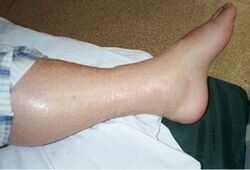Medicine:Transfusion associated circulatory overload
In transfusion medicine, transfusion associated circulatory overload (aka TACO) is a transfusion reaction (an adverse effect of blood transfusion) that can occur due to a rapid transfusion of a large volume of blood, but can also occur during a single red cell transfusion (about 15% of cases).[2] The fluid volume causes hypervolemia.
Symptoms and signs
The primary symptoms of TACO are dyspnea, orthopnea, peripheral edema, and rapid increase of blood pressure.[3] TACO must be suspected when there is respiratory distress with other signs, including pulmonary edema, unanticipated cardiovascular system changes, and evidence of fluid overload (including improvement after diuretic, morphine or nitrate treatment), during or up to 24 hours after transfusion.[2]
Risk factors
- Low albumin[4]
- Cardiovascular disease[5][6]
- Kidney disease[5][6]
- Lung disease[5]
- Severe anemia[5]
- Age (less than 3 years old and over 60 years old)[4]
Diagnosis
The International Society of Blood Transfusion (ISBT) working party on hemovigilance in collaboration with the International Haemovigilance Network (IHN) and AABB produced new reporting criteria in 2018.[5]
Patients classified with TACO should have acute onset or worsening respiratory distress or evidence of pulmonary edema, or both during or up to 12 hours after transfusion. They should have at least 3 of the following characteristics:
- Acute or worsening respiratory distress (tachypnoea, shortness of breath, cyanosis, and decreased oxygen saturations) in the absence of other causes
- Evidence of acute or worsening pulmonary edema (by physical examination, or chest imaging, or other non-invasive assessment of heart function e.g. echocardiogram)
- Evidence of unanticipated cardiovascular system changes (tachycardia, hypertension, widened pulse pressure, jugular venous distension, peripheral edema)
- Evidence of fluid overload (positive fluid balance, response to diuretic therapy with clinical improvement, change in the patient’s weight in the peri-transfusion period)
- Changes in a relevant biomarker e.g. elevation in natriuretic peptide (NP) levels (e.g. brain-natriuretic peptide (BNP), N-terminal (NT)-pro BNP) to greater than 1.5 times the pre-transfusion value.
Differential diagnosis
TACO and TRALI are both respiratory complications following a transfusion.[2] TACO and transfusion related acute lung injury (TRALI) are often difficult to distinguish in the acute situation. TACO is usually associated with hypertension and responds well to diuretics, TRALI is often associated with hypotension and diuretics have a minimal effect.[7][8][5] A normal natriuretic peptide level post-transfusion is seen with TRALI but not with TACO.
Prevention
Transfusion associated circulatory overload is prevented by avoiding unnecessary transfusions, closely monitoring patients receiving transfusions, transfusing smaller volumes of blood at a slower rate, and considering the use of furosemide as a diuretic.[2][3][9] A pre-transfusion TACO checklist can be used to assess patients' risk of developing TACO.[2][4]
Management
If TACO is suspected, the transfusion is stopped immediately and the person is treated with oxygen, diuretics, and other treatments for heart failure.[citation needed]
Occurrence
It is difficult to determine the incidence of TACO, but its incidence is estimated at about one in every 100 transfusions using active surveillance,[10][11] and in one in every 10000 transfusions using passive surveillance.[10] TACO is the most commonly reported cause of transfusion-related death and major morbidity in the UK,[2] and second most common cause in the USA.[12]
The risk increases with patients over the age of 60, patients with cardiac or pulmonary failure, renal impairment, hypoalbuminemia or anemia. [3][2]
References
- ↑ Agnihotri, Naveen; Agnihotri, Ajju (2014). "Transfusion associated circulatory overload". Indian Journal of Critical Care Medicine 18 (6): 396–398. doi:10.4103/0972-5229.133938. PMID 24987240.
- ↑ Jump up to: 2.0 2.1 2.2 2.3 2.4 2.5 2.6 Bolton-Maggs, Paula (Ed); Poles, D; et al, on behalf of the Serious Hazards of Transfusion (SHOT) Steering Group (2017). The 2016 Annual SHOT Report (2017). Serious Hazards of Transfusion (SHOT). ISBN 978-0-9558648-9-6. https://www.shotuk.org/wp-content/uploads/SHOT-Report-2016_web_7th-July.pdf.
- ↑ Jump up to: 3.0 3.1 3.2 Noninfectious Adverse Events of Transfusion - Transfusion Transmitted Injuries Section - Blood Safety Surveillance and Health Care Acquired Infections Division - Public Health...
- ↑ Jump up to: 4.0 4.1 4.2 Bolton-Maggs, PHB; Poles, D, eds (2018). The 2017 Annual SHOT Report (2018). https://www.shotuk.org/wp-content/uploads/myimages/SHOT-Report-2017-WEB-Final-v4-25-9-18.pdf.
- ↑ Jump up to: 5.0 5.1 5.2 5.3 5.4 5.5 "Transfusion-associated circulatory overload (TACO)(2018)". http://www.isbtweb.org/fileadmin/user_upload/TACO_2018_definition_March_2019.pdf.
- ↑ Jump up to: 6.0 6.1 Clifford, Leanne; Jia, Qing; Subramanian, Arun; Yadav, Hemang; Schroeder, Darrell R.; Kor, Daryl J. (March 2017). "Risk Factors and Clinical Outcomes Associated with Perioperative Transfusion-associated Circulatory Overload". Anesthesiology 126 (3): 409–418. doi:10.1097/ALN.0000000000001506. PMID 28072601.
- ↑ Popovsky, M. A. (September 2006). "Transfusion-related acute lung injury and transfusion-associated circulatory overload". ISBT Science Series 1 (1): 107–111. doi:10.1111/j.1751-2824.2006.00046.x.
- ↑ Skeate, Robert C; Eastlund, Ted (November 2007). "Distinguishing between transfusion related acute lung injury and transfusion associated circulatory overload". Current Opinion in Hematology 14 (6): 682–687. doi:10.1097/MOH.0b013e3282ef195a. PMID 17898575.
- ↑ Alam, Asim; Lin, Yulia; Lima, Ana; Hansen, Mark; Callum, Jeannie L. (April 2013). "The prevention of transfusion-associated circulatory overload". Transfusion Medicine Reviews 27 (2): 105–112. doi:10.1016/j.tmrv.2013.02.001. ISSN 1532-9496. PMID 23465703. https://pubmed.ncbi.nlm.nih.gov/23465703.
- ↑ Jump up to: 10.0 10.1 Raval, J. S.; Mazepa, M. A.; Russell, S. L.; Immel, C. C.; Whinna, H. C.; Park, Y. A. (May 2015). "Passive reporting greatly underestimates the rate of transfusion-associated circulatory overload after platelet transfusion". Vox Sanguinis 108 (4): 387–392. doi:10.1111/vox.12234. PMID 25753261.
- ↑ Clifford, Leanne; Jia, Qing; Yadav, Hemang; Subramanian, Arun; Wilson, Gregory A.; Murphy, Sean P.; Pathak, Jyotishman; Schroeder, Darrell R. et al. (January 2015). "Characterizing the Epidemiology of Perioperative Transfusion-associated Circulatory Overload". Anesthesiology 122 (1): 21–28. doi:10.1097/ALN.0000000000000513. PMID 25611653.
- ↑ "Fatalities Reported to FDA Following Blood Collection and Transfusion Annual Summary for Fiscal Year 2015". https://www.fda.gov/BiologicsBloodVaccines/SafetyAvailability/ReportaProblem/TransfusionDonationFatalities/default.htm. Retrieved July 17, 2017.
External links


